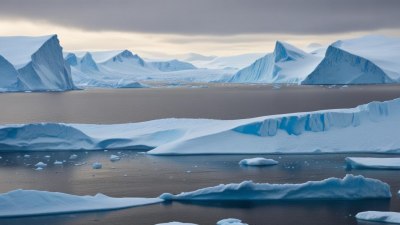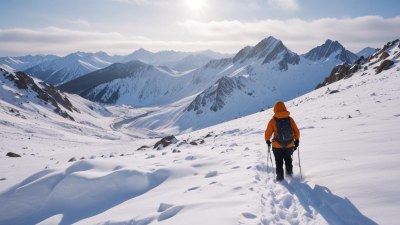How Antarctica Makes Every Other Cold Place Seem Overly Dramatic
Explore how Antarctica's extreme cold redefines the concept of winter and challenges perceptions of coldness worldwide.

This image was created with the assistance of Freepik
Antarctica, the southernmost continent, is often perceived as the epitome of coldness. It is an extraordinary place where the temperatures plummet to levels that challenge even the most resilient human spirit. With its icy landscapes and unyielding climate, Antarctica reshapes our understanding of cold and makes every other chilly locale appear almost mild in comparison.
To grasp the sheer chill of Antarctica, one must first comprehend its climatic conditions. The continent is surrounded by the Southern Ocean and is characterized by its vast ice sheets, which account for about 60% of the world's fresh water. The extreme elevation of the Antarctic Plateau contributes to its notoriously frigid temperatures. At times, the interior temperatures can drop below -60 degrees Celsius (-76 degrees Fahrenheit), and on certain occasions, even reach astonishing lows near -80 degrees Celsius (-112 degrees Fahrenheit). These are harsh realities that only a few places on Earth can match.
Considering factors like wind chill, the temperature feels even lower in Antarctica. The continent is home to polar winds that can howl over 100 kilometers per hour (62 mph), exacerbating the already severe cold. In contrast, most cold regions in the world, such as North America or Northern Europe, might experience drops to -30 degrees Celsius (-22 degrees Fahrenheit), but they often lack the relentless winds that can turn a relatively bearable chill into a bone-chilling experience.
The Unique Weather Patterns of Antarctica
Antarctica's weather patterns further distinguish it from other cold regions. The continent is known for its lack of precipitation, making it technically a desert, albeit one of the coldest on earth. Interestingly, the dryness means that even though the temperatures may reach extreme lows, the air remains relatively devoid of moisture. This contributes to a unique environment where conditions can shift rapidly. Through frostbite warnings, blizzards, and whiteout conditions, those in Antarctica will often express that their experience of cold is different from just about anywhere else.
It is imperative to recognize how the isolation of Antarctica accentuates the harshness of its climate. The nearest permanent human settlements are thousands of kilometers away, forcing researchers and adventurers to adapt to severe living conditions that few others can fathom. This remoteness adds to the mystique of Antarctica, as it has been a challenge for explorers and scientists alike. Countries have dedicated resources to study this exceptional land, not merely to understand the cold but to comprehend the planet's climatic changes through the lenses of its ice sheets.
The psychological aspect of enduring such stark conditions plays a pivotal role too. When discussing temperatures in a more temperate region, individuals can be deterred by the notion of snow or frost, perhaps speaking dramatically of how cold it feels. However, in Antarctica, the stakes are real. Individuals stationed at research bases have shared tales of living in sub-zero temperatures where survival becomes the foreground of every moment. The minimal ambient temperatures push them into survival mode, demonstrating an innate adaptation to an environment that is hostile to human life.
The Ice and its Significance
Ice is another key component that defines Antarctica, making it a living monument to climate change and its pervasive effects. The iconic ice shelves—the floating extensions of the continental ice sheet—are like the cliff notes of our planet's health. Researchers highlight how shrinking glaciers and diminishing ice coverage signify broader ecological shifts that may not only impact the Antarctic region but ultimately affect sea levels worldwide.
Contrarily, places like Canada or Scandanavia may boast their share of glaciers, yet the scale of Antarctic ice is unparalleled. Comparisons can be drawn to the sprawling Glacier Bay in Alaska or the fjords of Norway, yet Antarctica remains unmatched with its incomprehensibly vast and solid ice. A notable iceberg can be the size of a city, bringing astonishing visuals to the icy expanse, yet despite their beauty, they are powerful symbols of change in our climate.
Human Adaptation and Resilience
Speaking of resilience, polar research has compelled scientists to innovate technologies that withstand the unforgiving environments of the Antarctic. The human spirit is robust, and there exists a remarkable sense of fellowship as scientists and personnel collaborate to overcome adversity. Heat conservation becomes an essential skill, designed through clothing, housing, and communal living styles that are specifically tailored to adapt to the climate.
In contrast, stories from colder locations often romanticize the cold with hot cocoa and cozy firesides. In Antarctica, hot beverages take on new meanings; they have become lifelines against the profound cold. The mental fortitude to endure extended periods of icy darkness paired with relentless cold reveals how Antarctica uniquely challenges human existence. In many ways, the encounters faced there have created an extraordinary community of individuals who share remarkable stories of survival.
Media Depictions and Cultural Perceptions
Every winter season, movies, and stories surface depicting winter wonderlands filled with snowmen, cheerful snowball fights, and idyllic landscapes. Yet, these potent images rarely reflect the true severity of extreme cold. Antarctica, however, remains an unparalleled symbol of desolation, providing a stark contrast that elicits introspective reflections on our environment. Films like 'March of the Penguins' and 'The Iceman' portray yet romanticize survival against all odds and create a pathos that places Antarctica at the forefront of coldness.
Collectively, we often associate traditional winter experiences with dramatic elements, yet their nature does not compare to the brutality of surviving in Antarctica. This imbalance highlights how other cold regions can seem almost theatrical when viewed through the lens of Antarctic realities. From cultural references that awe at the beauty of snowflakes to the contemplative silence only found in endless icy expanses, the contrast is vivid.
In conclusion, Antarctica's unmatched cold eloquently transforms our understanding of winter and cold climates. It stands as a reminder that other cold places, while certainly frigid, lack the unique extremes which characterize Antarctica. From its relentless climate to its colossal ice sheets, its spirit of survival echoes through the valleys of ice, inviting both awe and respect. The continent not only redefines what it means to be cold but serves as a powerful metaphor for human resilience against the forces of nature that can flourish far beyond comfort zones.
As we venture forth into discussions about climate change, visitors to Antarctica represent a critical intersection between exploration, scientific inquiry, and environmental advocacy. Ultimately, the continent reveals chilling truths about the world around us, compelling all regions to reevaluate their narratives of coldness against the backdrop of the excruciating beauty that is Antarctica.











